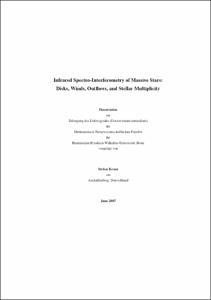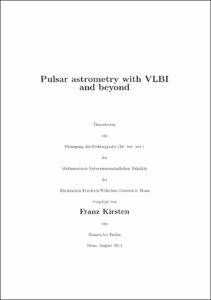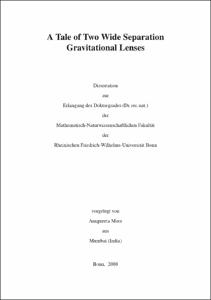Kraus, Stefan: Infrared Spectro-Interferometry of Massive Stars : Disks, Winds, Outflows, and Stellar Multiplicity. - Bonn, 2007. - Dissertation, Rheinische Friedrich-Wilhelms-Universität Bonn.
Online-Ausgabe in bonndoc: https://nbn-resolving.org/urn:nbn:de:hbz:5N-11272
Online-Ausgabe in bonndoc: https://nbn-resolving.org/urn:nbn:de:hbz:5N-11272
@phdthesis{handle:20.500.11811/3124,
urn: https://nbn-resolving.org/urn:nbn:de:hbz:5N-11272,
author = {{Stefan Kraus}},
title = {Infrared Spectro-Interferometry of Massive Stars : Disks, Winds, Outflows, and Stellar Multiplicity},
school = {Rheinische Friedrich-Wilhelms-Universität Bonn},
year = 2007,
note = {Interferometry is the ultimate technology for overcoming the limitations which diffraction and the atmosphere-induced seeing impose on the resolution achievable with ground-based telescopes. The latest generation of long-baseline interferometric instruments (in particular VLTI/AMBER and VLTI/MIDI), combines the high spatial resolution (typically a few milliarcseconds) with spectroscopic capabilities, allowing one to characterize the geometry of a continuum-emitting region over a wide spectral range or to spatially resolve the emitting region of Doppler-broadened spectral lines in many velocity channels.
One branch of astrophysics which might particularly benefit from these advances in technology is the study of massive (O-B type) stars. In order to characterize these stars and their companions and to study accretion and outflow processes in their vicinity with unprecedented angular resolution, we have performed interferometric studies on four key objects, representing the still most enigmatic evolutionary phases of massive stars; namely the pre-main-sequence (MWC 147, NGC 7538 IRS1, Theta 1 C) and the post-main-sequence phase (Eta Carinae).
MWC 147: As indicated by its strong infrared excess, this young Herbig Be star (B6-type) is still associated with residual material from its formation; maybe arranged in a circumstellar disk. In order to investigate the geometry of the material, we combined, for the first time, long-baseline spectro-interferometric observations at near- (NIR) and mid-infrared (MIR) wavelengths (using VLTI/AMBER, VLTI/MIDI, and archival PTI data). Fitting analytic models to the obtained interferometric data revealed a significant elongation of the continuum-emitting region. For a physical interpretation, we modeled the geometry of the dust distribution using 2-D radiative transfer simulations of Keplerian disks with and without a puffed-up inner rim, simultaneously fitting the wavelength-dependent visibilities and the SED, which we complemented with archival Spitzer/IRS spectra. Surprisingly, we found that passive disk models, which can reproduce the SED well, are in strong conflict with the interferometric data. However, when including emission from an optically thick inner gaseous disk, good quantitative agreement was found for all observables, suggesting that MWC 147 harbours a still actively accreting disk.
NGC 7538 IRS1/2: NGC 7538 IRS1 is a high-mass (O7-type) protostar with a CO outflow, an associated ultracompact H II region, and a linear methanol maser structure, which might trace a Keplerian-rotating circumstellar disk. We investigated the NIR morphology of the source with unprecedented resolution using NIR bispectrum speckle interferometry obtained at the BTA 6 m and the MMT 6.5 m telescopes. Our high-dynamic range images show fan-shaped outflow structures, in which we detected 18 stars and several blobs of diffuse emission. Complementary archival Spitzer/IRAC images were used to relate the detected structures with the outflow at larger scales. We found a misalignment of various outflow axes and interpreted this in the context of a disk precession model, also using molecular hydrodynamic simulations. As a possible triggering mechanism, we identified non-coplanar tidal interaction of an (yet undiscovered) close companion with the circumbinary disk. Finally, our observations resolved the nearby massive protostar NGC 7538 IRS2 as a close binary with a separation of 195 mas, finding indications for shock interaction between the outflows from IRS1 and IRS2.
Theta 1 Orionis C/D: Located in the Orion Trapezium Cluster, Theta 1 C is one of the youngest and nearest high-mass (O5-O7) stars. The star is also known to be a close binary system. We traced the orbital motion from 1997.8 to 2004.8 using visual and NIR bispectrum speckle interferometry at the BTA 6 m telescope. In 2005.9, we obtained first IOTA long-baseline interferometry on the Theta 1 C system, allowing us to derive preliminary solutions for the dynamical orbit and the dynamical mass. Taking the measured flux ratio and the derived location in the HR-diagram into account, we estimated the spectral types and masses of Theta 1 C1 and C2 to be O5.5 (M=34.0 M_sun) and O9.5 (M=15.5 M_sun), respectively. Thus, the companion C2 appears to be much more massive than previously thought, suggesting strong wind-wind interaction during the periastron passage, which we predict for epoch 2007.5 with a small physical separation of only approx. 1.5 AU. From the IOTA data on Theta 1 C, we reconstructed the first optical aperture synthesis image of a young star. We also obtained IOTA data for Theta 1 D, which appears resolved, perhaps indicating the presence of a close, faint companion.
Eta Carinae: Using VLTI/AMBER, we performed the first NIR spectro-interferometry of the Luminous Blue Variable (LBV) Eta Car, simultaneously obtaining high spatial and spectral resolutions (R=1,500 and 12,000). The measured wavelength-dependent visibilities, differential phases, and closure phases were used to constrain the geometry of the continuum-emitting region, as well as the Br Gamma 2.166 micron and He I 2.059 micron line-emitting region. We compared the measured visibilities with predictions of the radiative transfer model of Hillier et al. (2001), finding good agreement. For the interpretation of the non-zero differential and closure phases measured within the Br Gamma line, we present a simple geometric model of an inclined, latitude-dependent wind zone. Thus, our observations support theoretical models of anisotropic winds from fast-rotating, luminous hot stars with enhanced high-velocity mass loss near the polar regions. In the He I line, we measured non-zero phases as well, indicating asymmetries in the brightness distribution, which we discuss in the context of wind-wind interaction between Eta Car and its hypothetical hot binary companion. Using simulations, we examined the possibility to directly detect this companion in future observations.
Besides these astrophysical results of my dissertation, I present work related to methodological and technical aspects of infrared interferometry. The principles of a data reduction software developed for IOTA/IONIC3 and a pipeline for VLTI/AMBER are discussed. Furthermore, I summarize comparative studies which aim to evaluate the performance of different image reconstruction algorithms in order to explore the prospects and limitations of optical aperture synthesis imaging.},
url = {https://hdl.handle.net/20.500.11811/3124}
}
urn: https://nbn-resolving.org/urn:nbn:de:hbz:5N-11272,
author = {{Stefan Kraus}},
title = {Infrared Spectro-Interferometry of Massive Stars : Disks, Winds, Outflows, and Stellar Multiplicity},
school = {Rheinische Friedrich-Wilhelms-Universität Bonn},
year = 2007,
note = {Interferometry is the ultimate technology for overcoming the limitations which diffraction and the atmosphere-induced seeing impose on the resolution achievable with ground-based telescopes. The latest generation of long-baseline interferometric instruments (in particular VLTI/AMBER and VLTI/MIDI), combines the high spatial resolution (typically a few milliarcseconds) with spectroscopic capabilities, allowing one to characterize the geometry of a continuum-emitting region over a wide spectral range or to spatially resolve the emitting region of Doppler-broadened spectral lines in many velocity channels.
One branch of astrophysics which might particularly benefit from these advances in technology is the study of massive (O-B type) stars. In order to characterize these stars and their companions and to study accretion and outflow processes in their vicinity with unprecedented angular resolution, we have performed interferometric studies on four key objects, representing the still most enigmatic evolutionary phases of massive stars; namely the pre-main-sequence (MWC 147, NGC 7538 IRS1, Theta 1 C) and the post-main-sequence phase (Eta Carinae).
MWC 147: As indicated by its strong infrared excess, this young Herbig Be star (B6-type) is still associated with residual material from its formation; maybe arranged in a circumstellar disk. In order to investigate the geometry of the material, we combined, for the first time, long-baseline spectro-interferometric observations at near- (NIR) and mid-infrared (MIR) wavelengths (using VLTI/AMBER, VLTI/MIDI, and archival PTI data). Fitting analytic models to the obtained interferometric data revealed a significant elongation of the continuum-emitting region. For a physical interpretation, we modeled the geometry of the dust distribution using 2-D radiative transfer simulations of Keplerian disks with and without a puffed-up inner rim, simultaneously fitting the wavelength-dependent visibilities and the SED, which we complemented with archival Spitzer/IRS spectra. Surprisingly, we found that passive disk models, which can reproduce the SED well, are in strong conflict with the interferometric data. However, when including emission from an optically thick inner gaseous disk, good quantitative agreement was found for all observables, suggesting that MWC 147 harbours a still actively accreting disk.
NGC 7538 IRS1/2: NGC 7538 IRS1 is a high-mass (O7-type) protostar with a CO outflow, an associated ultracompact H II region, and a linear methanol maser structure, which might trace a Keplerian-rotating circumstellar disk. We investigated the NIR morphology of the source with unprecedented resolution using NIR bispectrum speckle interferometry obtained at the BTA 6 m and the MMT 6.5 m telescopes. Our high-dynamic range images show fan-shaped outflow structures, in which we detected 18 stars and several blobs of diffuse emission. Complementary archival Spitzer/IRAC images were used to relate the detected structures with the outflow at larger scales. We found a misalignment of various outflow axes and interpreted this in the context of a disk precession model, also using molecular hydrodynamic simulations. As a possible triggering mechanism, we identified non-coplanar tidal interaction of an (yet undiscovered) close companion with the circumbinary disk. Finally, our observations resolved the nearby massive protostar NGC 7538 IRS2 as a close binary with a separation of 195 mas, finding indications for shock interaction between the outflows from IRS1 and IRS2.
Theta 1 Orionis C/D: Located in the Orion Trapezium Cluster, Theta 1 C is one of the youngest and nearest high-mass (O5-O7) stars. The star is also known to be a close binary system. We traced the orbital motion from 1997.8 to 2004.8 using visual and NIR bispectrum speckle interferometry at the BTA 6 m telescope. In 2005.9, we obtained first IOTA long-baseline interferometry on the Theta 1 C system, allowing us to derive preliminary solutions for the dynamical orbit and the dynamical mass. Taking the measured flux ratio and the derived location in the HR-diagram into account, we estimated the spectral types and masses of Theta 1 C1 and C2 to be O5.5 (M=34.0 M_sun) and O9.5 (M=15.5 M_sun), respectively. Thus, the companion C2 appears to be much more massive than previously thought, suggesting strong wind-wind interaction during the periastron passage, which we predict for epoch 2007.5 with a small physical separation of only approx. 1.5 AU. From the IOTA data on Theta 1 C, we reconstructed the first optical aperture synthesis image of a young star. We also obtained IOTA data for Theta 1 D, which appears resolved, perhaps indicating the presence of a close, faint companion.
Eta Carinae: Using VLTI/AMBER, we performed the first NIR spectro-interferometry of the Luminous Blue Variable (LBV) Eta Car, simultaneously obtaining high spatial and spectral resolutions (R=1,500 and 12,000). The measured wavelength-dependent visibilities, differential phases, and closure phases were used to constrain the geometry of the continuum-emitting region, as well as the Br Gamma 2.166 micron and He I 2.059 micron line-emitting region. We compared the measured visibilities with predictions of the radiative transfer model of Hillier et al. (2001), finding good agreement. For the interpretation of the non-zero differential and closure phases measured within the Br Gamma line, we present a simple geometric model of an inclined, latitude-dependent wind zone. Thus, our observations support theoretical models of anisotropic winds from fast-rotating, luminous hot stars with enhanced high-velocity mass loss near the polar regions. In the He I line, we measured non-zero phases as well, indicating asymmetries in the brightness distribution, which we discuss in the context of wind-wind interaction between Eta Car and its hypothetical hot binary companion. Using simulations, we examined the possibility to directly detect this companion in future observations.
Besides these astrophysical results of my dissertation, I present work related to methodological and technical aspects of infrared interferometry. The principles of a data reduction software developed for IOTA/IONIC3 and a pipeline for VLTI/AMBER are discussed. Furthermore, I summarize comparative studies which aim to evaluate the performance of different image reconstruction algorithms in order to explore the prospects and limitations of optical aperture synthesis imaging.},
url = {https://hdl.handle.net/20.500.11811/3124}
}









